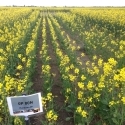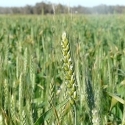23 Aug 2012
Best practice management of nitrogen and sulfur for canola and cereals – the Mallee.
Plant Nutrition – what are the fundamentals:
1. You get nothing for nothing – inputs need to be addressed relative to realistic outputs.
2. Address the limiting factor/s – it is no good pumping up the tyres if the tractor is out of fuel.
3. There are no ‘silver bullets’ – if something sounds to good to be true……..
Nutrition under rainfed conditions
When thinking about nutrition in the Mallee, there are a couple of important considerations that moderate our thinking. Generally the yield potential is driven by rainfall and accessible stored water. Subsoil limitations will restrict yield potential by restricting the amount of nutrient and water available to the roots – in this case, providing nutrients in small doses to prevent them getting beyond the roots is important. In both cases realistic yield estimates should drive the crop fertilizer program.
Secondly, dunes and swales represent quite contrasting soil types and so nutrient management needs to be adjusted accordingly. Dunes can be quite leached and so often lower in mobile nutrients (N & S), but the lighter soil can be more responsive to lighter rainfalls. The generally heavier soil in the swales can have better nutrient levels, but will need more water to get these nutrients into the crop. The dunes can also be quite alkaline, especially if they are a little blown down, and this means the plants will be battling soil chemistry to compete for P and Zn in particular. There are not yet any options for in-crop P, but foliar Zn can be useful if symptoms are present. It also seems there are reports of low K on some lighter soils although there is a need to confirm this – and here tissue testing or in-crop test strips can provide a guide.
Finally, because of the variable climate and uncertain rainfall, it is prudent to roll nutrients out as the season develops. At sowing, application (especially of N and S) should aim to meet the crop demand until stem elongation in either canola or wheat, and then reassess the yield potential and nutrient demand in the light of the seasonal forecast. If there is moderate N (say 40 kg N/ha top 60 cm), the crop will not suffer undue N stress, and yields will respond to added N. Early N will stimulate growth (shoot numbers) while later N will stimulate grain protein, so balancing both is important.
N and S for wheat and canola
With those things in mind, selecting the right source (product) and applying it at the right rate, at the right time and putting it in the right place represent the keys to nutrient management, and these four Rights for wheat and canola are quite specific for the Mallee.
So with that introduction, why talk about N and S – what do they have in common? The common link is the proteins they from and the relative demands for each nutrient. Cereals typically have a grain N:S ratio of 15:1 while canola grain have a N:S of 7:1. So, the relative S demand of canola is twice the demand of cereals, and this is why we need to consider S particularly for canola. The total N demand for average wheat and canola crops is quite similar, but canola will need twice the S of cereals.
Table 1. Approximate nutrient removals (kg/ha) in canola and wheat crops.
Canola (2 t/ha) | Wheat (3 t/ha) | |
| Nitrogen | 70 | 63 |
| Phosphorus | 10 | 9 |
| Potassium | 14 | 11 |
| Sulfur | 10* | 4 |
Overview of N management for wheat and canola
Before worrying about S, the first challenge is to get N right. N demand can be estimated through a budget approach, and this requires a soil test (usually deep – to 60 cm) to estimate the amount of N at seeding. N supply will be supplemented by in-crop mineralization, which depends on soil organic matter and rainfall. The mineral N supply can then be balanced off against a potential N demand, which is usually considered as around twice crop removal (Table 1). Demand can be estimated using a French and Schulz estimate, or through Yield Prophet® or based on what is considered a reasonable for the season. MAP will supply some N near the seed, and for both wheat and canola, review the demand/supply equation at the start of stem elongation, and if the season looks OK, then add enough N so that N is not limiting your target yield. Each 25 mm of rain will increase canola yield by 0.3 t/ha and wheat yield by 0.45 t/ha, and this means N demand will increase by around 25 kg N for canola and 21 kg N for wheat. Managing N is really then about estimating yield and then balancing the N supply.
S Management using the 4-R Nutrient Stewardship PrinciplesThe 4-R Nutrient Stewardship Principles are that the Right Source of Nutrient is applied at the Right Rate, Right Time and Right Place to supply crop nutrient needs. These principles apply to all plant nutrients that are added as a supplement to nutrients used from the soil. S can be added in different sources and many sources can be effective if managed in the right way. Application of ammonium sulfate in the seed-row of canola could be very effective, but because required rates cause the N in the ammonium sulfate to exceed the ammonia tolerance of canola, germination mortality can be high and establishment of an adequate plant population stand is at risk.
The following are alternative ways of applying the 4-R principles to supply adequate amounts of needed S for the canola crop by changing the form and or placement of the S-containing product:
1. Spread out the needed application of S through the whole crop rotation.
2. Deep soil test for S, the top soil can be deficient while there may be adequate in the subsoil
3. Apply the S along with all other fertilizers in a side-band away from the seed-row.
4. Apply the S in a mid-row band along with the N, while the P and K are still applied in the seed-row.
5. Apply S later in the growth of the crop.
6. Apply a source of S that has both sulfate and fine-particle sized elemental S in the seed-row. Top-dressed S should be in the sulfate form.
CONCLUSIONS
Growing canola in rotation with cereal crops requires more attention to S management. Applying all required S in the seed-row blend of canola is difficult because of excess N coming from the ammonium phosphate and ammonium sulfate that is part of the blend. There are alternative ways to supply sufficient S and avoid excess N in the seed-row.




